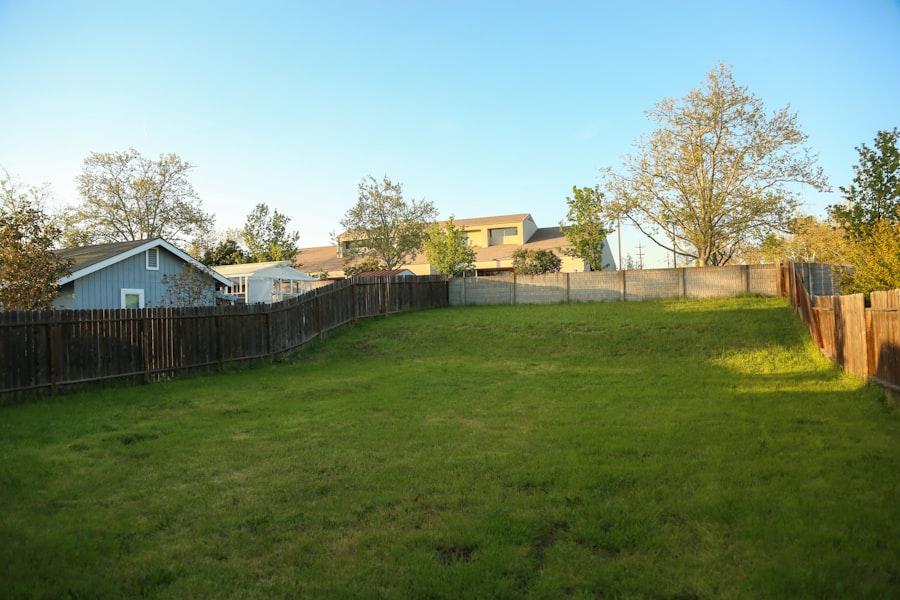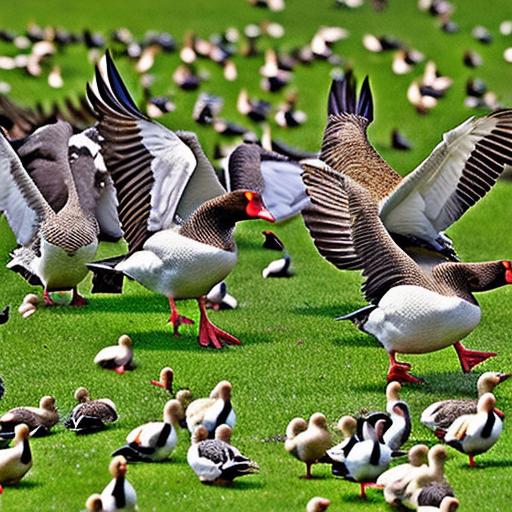Geese are known for their strong migratory instincts and their tendency to form strong social bonds. They are highly adaptable birds and can be found in a variety of habitats, including urban areas, parks, and golf courses. Geese are also known for their aggressive behavior, especially during the breeding season when they are protecting their nests and young. Understanding the behavior of geese is crucial in developing effective strategies for keeping them away from unwanted areas.
Geese are highly social animals and tend to gather in large flocks. They are also highly territorial and will aggressively defend their nesting sites and feeding areas. Geese are also known for their strong homing instincts, which means that once they have established a nesting site, they are likely to return to the same location year after year. This makes it important to address geese infestations as soon as possible to prevent them from becoming a recurring problem.
Key Takeaways
- Geese are territorial and protective of their nesting areas, which can lead to aggressive behavior towards humans.
- Natural deterrents for geese include planting tall grasses and shrubs, as well as using dogs to patrol the area.
- Physical barriers such as fences, hedges, and netting can effectively keep geese away from unwanted areas.
- Sound and visual deterrents like predator decoys, reflective tape, and ultrasonic devices can help to scare off geese.
- Repellents such as taste aversions and chemical deterrents can be used to discourage geese from staying in an area.
- Creating an unwelcoming environment for geese involves removing food sources, keeping grass short, and using motion-activated sprinklers.
- Seeking professional help for geese infestations may be necessary for large or persistent problems, and can involve wildlife management experts or pest control services.
Natural Deterrents for Geese
There are several natural deterrents that can be used to keep geese away from unwanted areas. One effective method is to introduce natural predators, such as dogs or birds of prey, to the area. The presence of these predators can help to discourage geese from settling in the area, as they will perceive it as a potential threat to their safety.
Another natural deterrent for geese is the use of reflective surfaces, such as mirrors or shiny objects. Geese are known to be wary of reflective surfaces, as they can perceive them as potential predators. By strategically placing reflective surfaces in areas where geese tend to gather, it is possible to discourage them from settling in those locations.
Physical Barriers to Keep Geese Away
Physical barriers can be an effective way to keep geese away from unwanted areas. One common method is the use of fencing or netting to create a barrier around the perimeter of the area. This can help to prevent geese from accessing the area and can also discourage them from attempting to land or nest in the vicinity.
Another physical barrier that can be used to keep geese away is the installation of floating barriers on bodies of water. These barriers can be used to create a physical barrier that prevents geese from accessing certain areas, such as swimming pools or ponds. The presence of these barriers can help to discourage geese from settling in these locations and can also help to protect the water from contamination.
Using Sound and Visual Deterrents
Sound and visual deterrents can be effective in keeping geese away from unwanted areas. One common method is the use of loud noises, such as propane cannons or bird distress calls, to deter geese from settling in certain locations. These noises can be used to create a sense of danger and can help to discourage geese from staying in the area.
Visual deterrents, such as scarecrows or predator decoys, can also be effective in keeping geese away. These visual deterrents can create the illusion of a potential threat and can help to discourage geese from settling in the area. By strategically placing these visual deterrents in areas where geese tend to gather, it is possible to create an environment that is less welcoming to them.
Repellents to Keep Geese at Bay
There are several repellents that can be used to keep geese at bay. One common method is the use of chemical repellents, such as methyl anthranilate, which is a non-toxic substance that irritates the mucous membranes of geese. This can help to discourage geese from settling in certain areas and can also help to protect vegetation from being damaged by their feeding habits.
Another repellent that can be used to keep geese at bay is the use of taste aversions, such as grape seed extract or bittering agents. These substances can be applied to vegetation or other surfaces that geese tend to feed on, which can help to discourage them from settling in those areas. By creating an environment that is less appealing to geese, it is possible to reduce the likelihood of infestations occurring.
Creating an Unwelcoming Environment for Geese

Creating an unwelcoming environment for geese is crucial in preventing infestations from occurring. One effective method is to modify the landscape to make it less appealing to geese. This can include removing or reducing areas of open water, which are attractive to geese for feeding and nesting. By reducing the availability of these resources, it is possible to discourage geese from settling in the area.
Another way to create an unwelcoming environment for geese is to use landscaping techniques that make it difficult for them to access certain areas. This can include planting dense vegetation or using barriers such as rocks or shrubs to create obstacles that prevent geese from accessing certain locations. By making it more difficult for geese to access these areas, it is possible to reduce the likelihood of infestations occurring.
Seeking Professional Help for Geese Infestations
In some cases, professional help may be necessary to address geese infestations effectively. There are companies that specialize in wildlife management and can provide expert assistance in developing strategies for keeping geese away from unwanted areas. These professionals can assess the specific needs of the area and develop a customized plan for addressing the infestation.
Professional wildlife management companies may also offer services such as habitat modification, which involves making changes to the landscape to make it less appealing to geese. This can include the installation of physical barriers, the use of sound and visual deterrents, and the application of repellents to keep geese at bay. By seeking professional help, it is possible to develop a comprehensive strategy for addressing geese infestations and preventing them from becoming a recurring problem.
In conclusion, understanding the behavior of geese is crucial in developing effective strategies for keeping them away from unwanted areas. There are several natural deterrents, physical barriers, sound and visual deterrents, repellents, and landscaping techniques that can be used to create an unwelcoming environment for geese and prevent infestations from occurring. In some cases, professional help may be necessary to address geese infestations effectively and develop a comprehensive plan for keeping them at bay. By implementing these strategies, it is possible to reduce the likelihood of geese infestations occurring and create a more welcoming environment for both humans and wildlife alike.
Looking to keep geese away from your yard? Check out this helpful article on PoultryWizard.com that offers tips and tricks for keeping chickens safe and secure in their coop. With practical advice and innovative solutions, you’ll find everything you need to create a peaceful and protected environment for your feathered friends. And while you’re at it, why not explore their other articles on topics like chicken coop trampolines and the compatibility of guinea fowl with chickens? Learn more here about creating a safe and happy home for your poultry.
FAQs
What are some effective methods to keep geese away from my yard?
Some effective methods to keep geese away from your yard include using visual deterrents such as scarecrows or reflective tape, using noise deterrents such as ultrasonic devices or noise-making machines, and using physical barriers such as fences or netting.
Are there any natural repellents that can keep geese away from my yard?
Yes, there are natural repellents that can help keep geese away from your yard. Some examples include planting tall grasses or shrubs around the perimeter of your yard, using predator decoys such as fake coyotes or dogs, and applying non-toxic repellent sprays made from natural ingredients.
Is it legal to use certain methods to keep geese away from my yard?
It is important to check local regulations and laws regarding the use of certain methods to keep geese away from your yard. Some areas may have restrictions on the use of certain deterrents or repellents, so it is best to research and comply with local laws.
What are some long-term solutions for keeping geese away from my yard?
Some long-term solutions for keeping geese away from your yard include modifying the landscape to make it less attractive to geese, such as removing sources of food and water, and using habitat modification techniques to discourage geese from nesting in your yard.
Are there any humane methods for keeping geese away from my yard?
Yes, there are humane methods for keeping geese away from your yard. These methods focus on deterring geese without causing harm, such as using visual or noise deterrents, and creating an environment that is less appealing to geese without causing them any harm.
Meet Walter, the feathered-friend fanatic of Florida! Nestled in the sunshine state, Walter struts through life with his feathered companions, clucking his way to happiness. With a coop that’s fancier than a five-star hotel, he’s the Don Juan of the chicken world. When he’s not teaching his hens to do the cha-cha, you’ll find him in a heated debate with his prized rooster, Sir Clucks-a-Lot. Walter’s poultry passion is no yolk; he’s the sunny-side-up guy you never knew you needed in your flock of friends!







